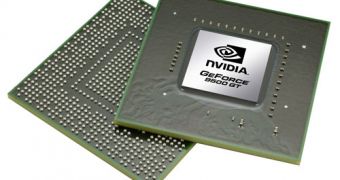It looks like the much anticipated GeForce 9800GT and 9500GT are finally out, with several of NVIDIA's channel partners having already introduced their own versions based on them. As expected, the new GeForce cards are designed for the entry-level and mid-range segments, which means that they will be affordable to most users.
"The addition of the new 9800 GTX+, 9800 GT, and the 9500 GT GPUs brings a new level of visual computing capability to additional mainstream market segments," said Ujesh Desai, general manager of desktop GPUs at NVIDIA. "NVIDIA GPUs deliver the best bang for the buck in each price category, and with support for CUDA, PhysX, and 3D stereoscopic technology, consumers can now experience the unique, innovative, and immersive computing experience that only NVIDIA can deliver." Desai further added.
The GeForce 9500GT has been designed with an entry-level user in mind, and will apparently sell for less than $100. The clock speed is set at 550MHz, while the standard version will provide its users with 1GB of DDR2 memory, running at 666MHz. Despite the obvious "devilish" association, the card's performance level is rather on the low side, offering a speed of 1400MHz for the Shaders and a memory bandwidth of 10.7GB/s. On the other hand, the low performance level makes it possible for the card to be used with a single-slot cooling system.
The mid-range GeForce 9800GT is set for more demanding tasks in terms of graphics, offering a GPU speed of 600MHz, while the Shaders are standardly clocked at 1500MHz. There are 112 Stream processors which, when coupled with the 512MB of GDDR3 memory, should provide some fairly generous frame rates. This card is also equipped with a single-slot cooling solution, which will probably be capable to withstand some overclocking. As with the 9500GT card, the mid-range 9800GT supports NVIDIA's SLI and PhysX technologies, which should increase the graphics performance of your desktop system.
The arrival of these new GeForce cards has been highly anticipated for quite some time now. Some even went as far as to speculate that one of the upcoming models would be built on a 55nm fabrication process, a thing that doesn?t appear to have happened.
Now that the new cards have finally been released, prepare for the most interesting part, in true NVIDIA style (since this also happened to most of its cards): we?ll see which manufacturer comes with the best offer and which one will provide the best factory-overclocked model.

 14 DAY TRIAL //
14 DAY TRIAL //